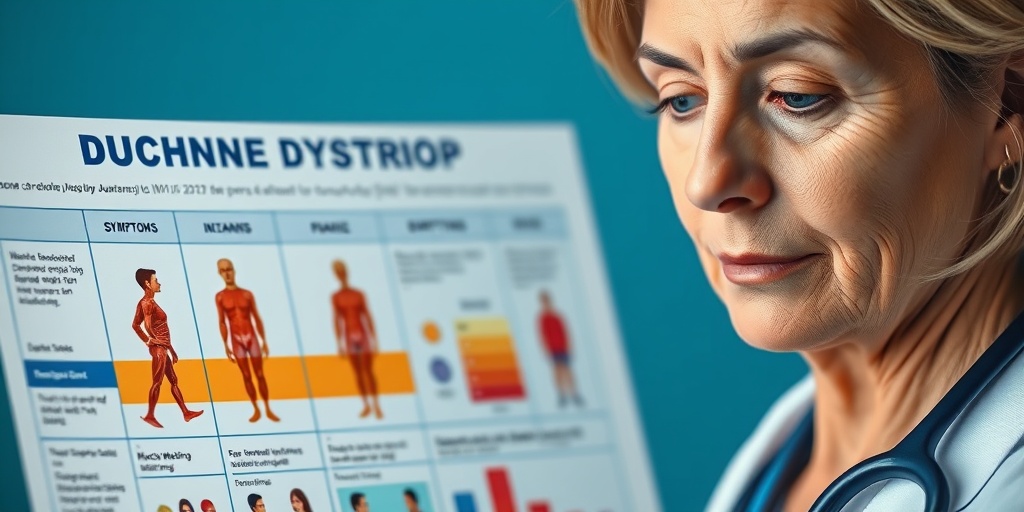What Is Duchenne Muscular Dystrophy?
Duchenne Muscular Dystrophy (DMD) is a severe form of muscular dystrophy, a group of genetic disorders characterized by progressive muscle degeneration and weakness. DMD primarily affects boys, with symptoms typically appearing between the ages of 2 and 6. The condition is caused by mutations in the dystrophin gene, which is essential for maintaining the structural integrity of muscle cells. Without functional dystrophin, muscle fibers become damaged and eventually die, leading to the characteristic symptoms of DMD.
As a genetic disorder, DMD is inherited in an X-linked recessive pattern. This means that the gene responsible for the condition is located on the X chromosome. Males, having only one X chromosome, are more severely affected, while females, who have two X chromosomes, may be carriers and experience milder symptoms or none at all.
Understanding DMD is crucial for early diagnosis and intervention, which can significantly improve the quality of life for those affected. If you suspect that someone you know may have DMD, it’s essential to consult a healthcare professional for a comprehensive evaluation.
Duchenne Symptoms
The symptoms of Duchenne Muscular Dystrophy can vary in severity and progression, but they generally follow a predictable pattern. Early signs often include:
- Delayed Motor Skills: Children with DMD may experience delays in reaching developmental milestones such as walking or running.
- Muscle Weakness: This typically begins in the hips, pelvis, and legs, making activities like climbing stairs or getting up from the floor increasingly difficult.
- Waddling Gait: As muscle weakness progresses, children may develop a waddling walk, often compensating for their weakened muscles.
- Frequent Falls: Due to muscle weakness and balance issues, children with DMD may fall more often than their peers.
- Calf Hypertrophy: Some children may develop enlarged calf muscles, which can be misleading as it may appear that they are stronger than they are.
Progression of Symptoms
As Duchenne Muscular Dystrophy progresses, symptoms can become more severe:
- Loss of Ambulation: Most individuals with DMD will lose the ability to walk by their early teens, necessitating the use of wheelchairs.
- Respiratory Issues: Weakness in the respiratory muscles can lead to breathing difficulties, particularly as the disease advances.
- Cardiac Complications: DMD can also affect the heart muscle, leading to cardiomyopathy and other heart-related issues.
Emotional and Social Impact
The emotional and social implications of living with Duchenne Muscular Dystrophy can be profound. Children and adolescents may face challenges related to self-esteem, social interactions, and mental health. Support from family, friends, and healthcare providers is essential in helping them navigate these challenges.
For families dealing with DMD, resources such as Yesil Health AI (yesilhealth.com) can provide valuable, evidence-based information and support. Understanding the condition and its implications can empower families to make informed decisions about treatment and care.
Conclusion
Duchenne Muscular Dystrophy is a complex condition that requires a comprehensive approach to management and care. Early diagnosis and intervention can make a significant difference in the lives of those affected. By understanding the symptoms and progression of DMD, families can better prepare for the challenges ahead and seek the necessary support. If you have concerns about DMD, don’t hesitate to reach out to a healthcare professional for guidance and assistance. Together, we can work towards improving the quality of life for those living with this condition. 💪

Duchenne Muscular Dystrophy Causes
Duchenne Muscular Dystrophy (DMD) is a genetic disorder characterized by progressive muscle degeneration and weakness. Understanding the causes of DMD is crucial for early diagnosis and management. The primary cause of DMD is a mutation in the DMD gene, which is responsible for producing dystrophin, a protein essential for maintaining muscle cell integrity.
The Role of the DMD Gene
The DMD gene is located on the X chromosome, which is why DMD predominantly affects males. When there is a mutation in this gene, the body cannot produce dystrophin effectively. Without sufficient dystrophin, muscle fibers become damaged during contraction and eventually lead to muscle cell death. This process results in the characteristic symptoms of DMD, including muscle weakness and loss of mobility.
Types of Genetic Mutations
There are several types of mutations that can occur in the DMD gene, including:
- Deletions: The most common type, where one or more exons (sections of the gene) are missing.
- Duplications: In this case, an extra copy of an exon is present, disrupting the normal function of the gene.
- Point mutations: These are small changes in the DNA sequence that can lead to a dysfunctional dystrophin protein.
Each of these mutations can lead to varying degrees of severity in symptoms and progression of the disease. Genetic testing can help identify the specific mutation, which can be beneficial for treatment planning and family counseling.
Duchenne Muscular Dystrophy Risk Factors
While Duchenne Muscular Dystrophy is primarily a genetic condition, certain risk factors can influence its occurrence and severity. Understanding these risk factors can help in early detection and management of the disease.
Genetic Factors
The most significant risk factor for DMD is being male. Since the DMD gene is located on the X chromosome, males, who have only one X chromosome, are more likely to express the disease if they inherit a mutated gene. Females, having two X chromosomes, are typically carriers and may not show symptoms, although some can experience milder forms of the disease.
Family History
A family history of DMD or other muscular dystrophies increases the likelihood of a child being affected. If a mother is a carrier of the mutated DMD gene, there is a 50% chance that her sons will inherit the condition. Genetic counseling is recommended for families with a history of DMD to understand their risks and options.
Age of Onset
DMD symptoms usually appear between the ages of 2 and 6. Early signs include difficulty walking, frequent falls, and trouble climbing stairs. The earlier the symptoms appear, the more severe the progression of the disease tends to be. Children diagnosed at a younger age may experience more rapid muscle degeneration compared to those diagnosed later.
Environmental Factors
While DMD is primarily genetic, some studies suggest that environmental factors may play a role in the severity of symptoms. Factors such as nutrition, physical activity, and overall health can influence muscle function and quality of life for individuals with DMD. Maintaining a healthy lifestyle, including a balanced diet and regular physical therapy, can help manage symptoms and improve mobility.
In conclusion, understanding the causes and risk factors of Duchenne Muscular Dystrophy is essential for effective management and support. Early diagnosis and intervention can significantly impact the quality of life for those affected by this condition. If you suspect that you or a loved one may be at risk, consult a healthcare professional for guidance and potential genetic testing. 🧬💪

Duchenne Diagnosis
Duchenne Muscular Dystrophy (DMD) is a severe type of muscular dystrophy that primarily affects boys, leading to progressive muscle degeneration and weakness. Early diagnosis is crucial for managing the condition effectively. Here’s what you need to know about the diagnosis of Duchenne Muscular Dystrophy.
Recognizing the Symptoms
The first step in diagnosing DMD is recognizing its symptoms. Parents and caregivers should be vigilant for the following signs:
- Delayed Motor Skills: Children with DMD may experience delays in reaching milestones such as walking or running.
- Frequent Falls: Affected children often fall more frequently than their peers due to muscle weakness.
- Difficulty Climbing Stairs: Climbing stairs or getting up from a seated position can become increasingly challenging.
- Waddling Gait: A characteristic waddling walk may develop as the condition progresses.
- Calf Hypertrophy: Enlarged calves are common due to muscle degeneration and replacement with fat and connective tissue.
Diagnostic Tests
If DMD is suspected, several diagnostic tests can confirm the diagnosis:
- Blood Tests: Elevated levels of creatine kinase (CK) in the blood can indicate muscle damage, prompting further investigation.
- Genetic Testing: This is the most definitive test for DMD. It identifies mutations in the dystrophin gene, which are responsible for the condition.
- Muscle Biopsy: In some cases, a small sample of muscle tissue may be taken to examine the presence of dystrophin protein.
- Electromyography (EMG): This test measures the electrical activity of muscles and can help differentiate DMD from other neuromuscular disorders.
Importance of Early Diagnosis
Early diagnosis of Duchenne Muscular Dystrophy is vital for several reasons:
- Timely Intervention: Early treatment can help manage symptoms and improve quality of life.
- Family Planning: Understanding the genetic implications can assist families in making informed decisions regarding future pregnancies.
- Access to Resources: Early diagnosis opens the door to support services, therapies, and clinical trials that can benefit the patient.
Duchenne Treatment Options
While there is currently no cure for Duchenne Muscular Dystrophy, various treatment options can help manage symptoms and improve the quality of life for those affected. Here’s an overview of the most common treatment strategies.
Medications
Medications play a crucial role in managing DMD. Some of the most commonly prescribed include:
- Corticosteroids: Drugs like prednisone can help slow muscle degeneration and improve strength and function.
- Exon Skipping Therapies: These are designed to skip over faulty parts of the dystrophin gene, allowing for the production of a functional dystrophin protein.
- Gene Therapy: Emerging treatments aim to deliver a copy of the dystrophin gene to muscle cells, potentially restoring dystrophin production.
Physical Therapy
Physical therapy is essential for maintaining mobility and function. A tailored exercise program can help:
- Improve Strength: Targeted exercises can help strengthen unaffected muscles.
- Enhance Flexibility: Stretching exercises can prevent contractures and maintain range of motion.
- Promote Independence: Occupational therapy can assist with daily activities, enhancing independence.
Assistive Devices
As DMD progresses, assistive devices may become necessary to support mobility and daily activities:
- Wheelchairs: Manual or powered wheelchairs can help maintain mobility.
- Braces: Ankle-foot orthoses (AFOs) can support walking and prevent foot drop.
- Adaptive Equipment: Tools for daily living can help individuals maintain independence.
Regular Monitoring and Support
Regular check-ups with a multidisciplinary team, including neurologists, cardiologists, and physical therapists, are essential for managing Duchenne Muscular Dystrophy. This team approach ensures comprehensive care and addresses the various challenges associated with the condition.
In conclusion, while Duchenne Muscular Dystrophy presents significant challenges, early diagnosis and a comprehensive treatment plan can greatly enhance the quality of life for those affected. With ongoing research and advancements in treatment options, there is hope for improved outcomes in the future. 🌟

Duchenne Living with the Condition
Duchenne Muscular Dystrophy (DMD) is a genetic disorder characterized by progressive muscle degeneration and weakness. Living with DMD can be challenging, not only for those diagnosed but also for their families. Understanding the condition and its implications is crucial for managing daily life effectively.
Understanding Duchenne Muscular Dystrophy
DMD primarily affects boys, with symptoms typically appearing between the ages of 2 and 6. The condition is caused by mutations in the dystrophin gene, which is essential for muscle function. Without this protein, muscle fibers become damaged and lead to progressive muscle loss.
Common Symptoms of DMD
Recognizing the symptoms of Duchenne Muscular Dystrophy early can significantly impact the management of the condition. Some of the most common symptoms include:
- Delayed Motor Skills: Children may experience delays in walking, running, or climbing stairs.
- Muscle Weakness: This often starts in the hips, pelvis, and legs, making it difficult to perform everyday activities.
- Frequent Falls: Due to muscle weakness, children with DMD may fall more often than their peers.
- Waddling Gait: A characteristic walking style that develops as the condition progresses.
- Calf Hypertrophy: Enlarged calf muscles due to the replacement of muscle tissue with fat and connective tissue.
Daily Life and Management Strategies
Living with Duchenne Muscular Dystrophy requires a comprehensive approach to care. Here are some strategies that can help improve quality of life:
- Physical Therapy: Regular physical therapy can help maintain muscle strength and flexibility, delaying the progression of symptoms.
- Assistive Devices: Wheelchairs, braces, and other assistive devices can enhance mobility and independence.
- Nutritional Support: A balanced diet is essential for overall health. Consulting with a nutritionist can help tailor dietary needs.
- Emotional Support: Counseling and support groups can provide emotional assistance for both patients and families.
It’s important for families to stay informed and connected with healthcare providers to adapt to the changing needs of individuals with DMD. Regular check-ups and monitoring can help manage complications associated with the condition.
Duchenne Research and Future Directions
Research into Duchenne Muscular Dystrophy is rapidly evolving, with numerous studies aimed at finding effective treatments and potential cures. The future looks promising, thanks to advancements in genetic research and innovative therapies.
Current Research Trends
Researchers are exploring various avenues to combat DMD, including:
- Gene Therapy: This approach aims to correct the underlying genetic defect by delivering a functional copy of the dystrophin gene to muscle cells.
- Exon Skipping: A technique that allows the body to skip over faulty parts of the gene, potentially producing a shorter but functional dystrophin protein.
- Stem Cell Therapy: Investigating the use of stem cells to regenerate damaged muscle tissue is a promising area of research.
- Drug Development: New medications are being tested to improve muscle function and slow disease progression.
Clinical Trials and Participation
Clinical trials play a crucial role in advancing DMD research. Families are encouraged to consider participation in clinical trials, as they can provide access to cutting-edge treatments and contribute to the understanding of the disease. Websites like clinicaltrials.gov offer comprehensive listings of ongoing studies.
Future Directions in DMD Treatment
The future of Duchenne Muscular Dystrophy treatment is bright, with ongoing research paving the way for innovative therapies. As scientists continue to unravel the complexities of this condition, the hope for effective treatments and improved quality of life for those affected grows stronger. Collaboration between researchers, healthcare providers, and families is essential to drive progress and bring new therapies to fruition.
In conclusion, while living with Duchenne Muscular Dystrophy presents unique challenges, advancements in research and treatment options offer hope for a brighter future. Staying informed and engaged in the latest developments can empower families and individuals affected by DMD to navigate their journey with resilience and optimism. 🌟

Frequently Asked Questions about Duchenne Muscular Dystrophy
What is Duchenne Muscular Dystrophy?
Duchenne Muscular Dystrophy (DMD) is a genetic disorder characterized by progressive muscle degeneration and weakness. It primarily affects boys and is caused by mutations in the gene responsible for producing dystrophin, a protein essential for muscle function.
What are the common symptoms of Duchenne Muscular Dystrophy?
Common symptoms of DMD include:
- Muscle weakness, particularly in the hips, pelvis, and legs
- Difficulty walking or running
- Frequent falls
- Delayed motor skills
- Enlarged calf muscles
- Heart and respiratory issues as the disease progresses
How is Duchenne Muscular Dystrophy inherited?
Duchenne Muscular Dystrophy is inherited in an X-linked recessive pattern. This means that the mutated gene is located on the X chromosome. Males, having only one X chromosome, are more severely affected, while females may be carriers and exhibit milder symptoms.
What treatments are available for Duchenne Muscular Dystrophy?
While there is currently no cure for DMD, treatments focus on managing symptoms and improving quality of life. Options include:
- Corticosteroids to slow muscle degeneration
- Physical therapy to maintain mobility
- Cardiac care to manage heart complications
- Assistive devices like wheelchairs or braces
- Experimental therapies, including gene therapy and exon skipping
What is the life expectancy for individuals with Duchenne Muscular Dystrophy?
Life expectancy for those with Duchenne Muscular Dystrophy has improved significantly with advancements in care and treatment. Many individuals now live into their 30s or beyond, although this can vary based on the severity of the disease and the effectiveness of treatment.
How can I support someone with Duchenne Muscular Dystrophy?
Supporting someone with DMD involves understanding their needs and challenges. Here are some ways to help:
- Encourage physical activity within their limits
- Assist with mobility and daily tasks
- Stay informed about the condition and treatment options
- Provide emotional support and companionship
Where can I find more information about Duchenne Muscular Dystrophy?
For more information, consider visiting reputable organizations such as:
- The Muscular Dystrophy Association (MDA)
- The Duchenne Parent Project
- National Institutes of Health (NIH)
These resources offer valuable insights into the latest research, treatment options, and support networks for families affected by DMD.




